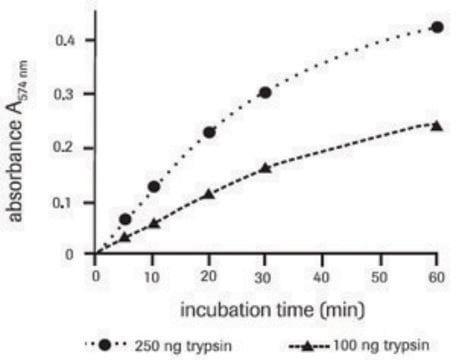C3777
Casein fluorescein isothiocyanate from bovine milk
Type II, essentially salt-free, lyophilized powder
Synonym(s):
FITC-casein
Sign Into View Organizational & Contract Pricing
All Photos(2)
About This Item
Recommended Products
type
Type II
form
essentially salt-free, lyophilized powder
extent of labeling
20-50 μg FITC per mg solid
solubility
water: 5 mg/mL, clear to hazy, yellow to orange
storage temp.
2-8°C
Looking for similar products? Visit Product Comparison Guide
General description
Casein is a major milk phospho-protein and constitutes about 80% of the total protein content in milk. Bovine milk is composed of four types of casein such as, αS1, αS2, β, and κ. Casein exists as micelles in milk.
Application
Casein fluorescein isothiocyanate from bovine milk has been used:
- as a substrate for semi-quantitative analysis of protease in Arabidopsis cells
- to determine the caseinolytic activity of secreted LasB (elastase), alkaline protease and protease IV
- for determining the SpeB (cysteine protease) proteolytic activity in Streptococcus pyogenes cells
highly sensitive protease substrate
Biochem/physiol Actions
Casein micelle system is involved in the prevention of pathological calcification of mammary glands.
Storage Class Code
11 - Combustible Solids
WGK
WGK 3
Flash Point(F)
Not applicable
Flash Point(C)
Not applicable
Personal Protective Equipment
dust mask type N95 (US), Eyeshields, Gloves
Certificates of Analysis (COA)
Search for Certificates of Analysis (COA) by entering the products Lot/Batch Number. Lot and Batch Numbers can be found on a product’s label following the words ‘Lot’ or ‘Batch’.
Already Own This Product?
Find documentation for the products that you have recently purchased in the Document Library.
Customers Also Viewed
Invited review: Understanding the behavior of caseins in milk concentrates
Corredig M, et al.
Journal of Dairy Science, 102(6), 4772-4782 (2019)
Casein and Whey Proteins in Human Health
Milk and Dairy Products as Functional Foods, 102(6), 94-146 (2014)
Cationic antimicrobial peptides disrupt the Streptococcus pyogenes ExPortal
Vega LA and Caparon MG
Molecular Microbiology, 85(6), 1119-1132 (2012)
Mark F Mabanglo et al.
Communications biology, 2, 410-410 (2019-11-23)
Bacterial ClpP is a highly conserved, cylindrical, self-compartmentalizing serine protease required for maintaining cellular proteostasis. Small molecule acyldepsipeptides (ADEPs) and activators of self-compartmentalized proteases 1 (ACP1s) cause dysregulation and activation of ClpP, leading to bacterial cell death, highlighting their potential
Laura Reinhardt et al.
mBio, 13(6), e0141322-e0141322 (2022-10-27)
Clp proteases consist of a proteolytic, tetradecameric ClpP core and AAA+ Clp-ATPases. Streptomycetes, producers of a plethora of secondary metabolites, encode up to five different ClpP homologs, and the composition of their unusually complex Clp protease machinery has remained unsolved.
Our team of scientists has experience in all areas of research including Life Science, Material Science, Chemical Synthesis, Chromatography, Analytical and many others.
Contact Technical Service












